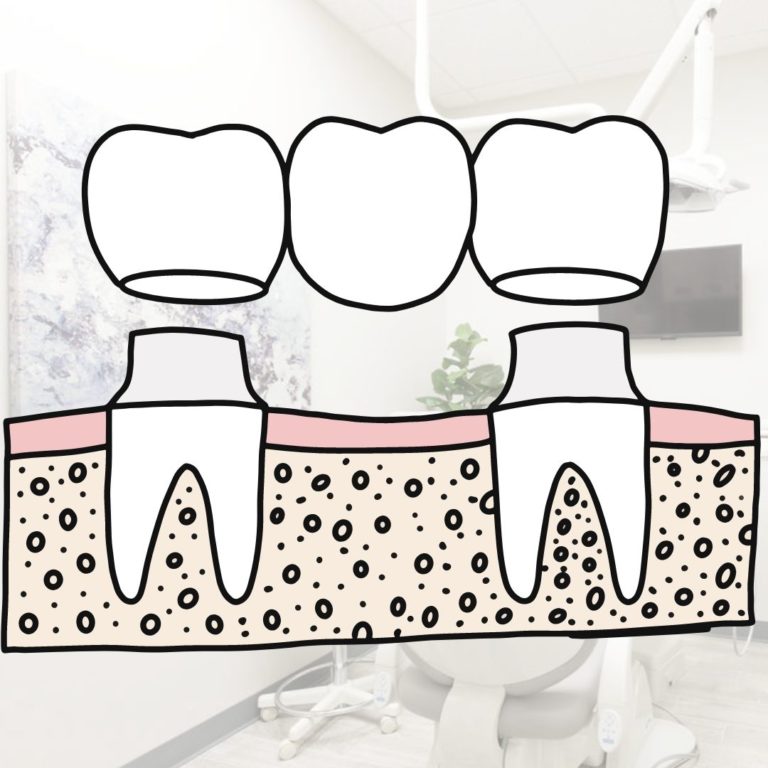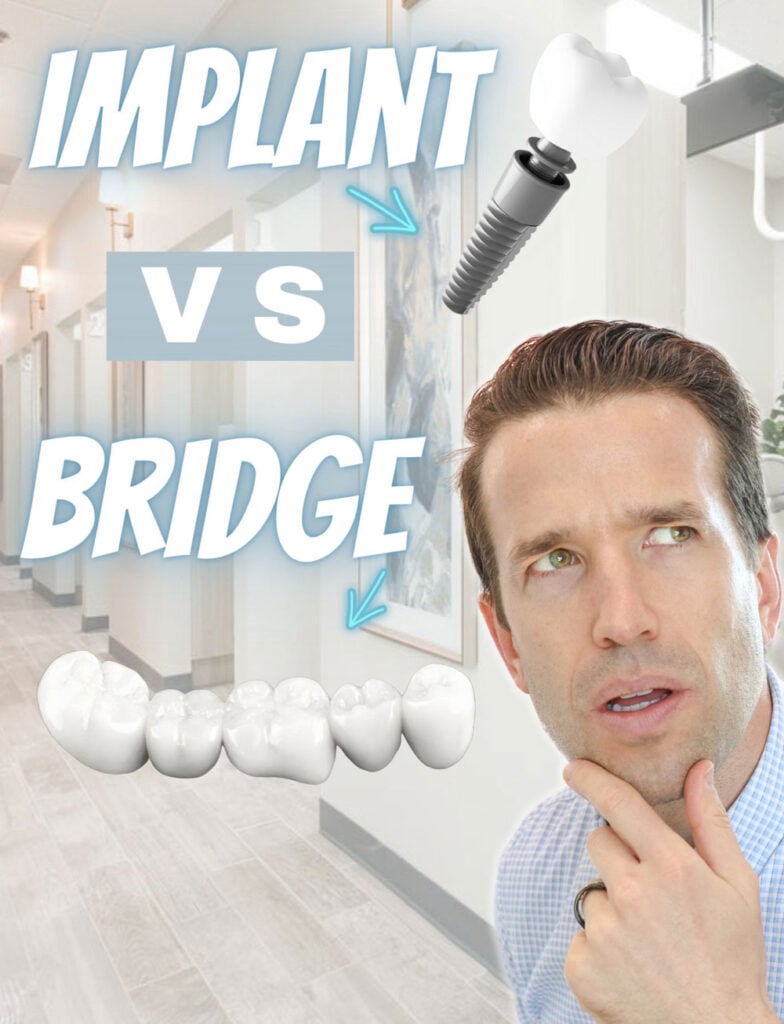Are you trying to determine if a Dental Bridge or Dental Implant is a better option? I’m going to go through the top reasons you should get a bridge, the top reasons you should get an implant, the pros and cons, and the pricing so you can be the best, most informed patient ever.
What is a dental bridge?
Let’s first start by defining what a bridge is. A bridge uses two adjacent teeth as anchors for the tooth that’s missing.
How a bridge works is you must compare those two adjacent teeth to put a bridge on that tooth. you have to use adjacent teeth to replace the missing tooth. Contrary to that, with an implant, it doesn’t matter what teeth you have beside it because you’re going to screw an implant into the bone, let that heal up, and then put a crown on top.
What is a dental implant?
An implant is made of titanium, but the interesting thing between an implant and a bridge is the crown, or the portion you see is very similar. The crown will be some version of porcelain that looks good and matches your teeth very well or as close to perfect as possible.
Advantages and disadvantages of both
All right, you know what a bridge is; you know what an implant is. Let’s talk about the advantages and disadvantages of both.
The advantage of a bridge is that it’s very quick to get one completed. It takes two visits to get your dental bridge. Some offices can get you a bridge on the same day! Within two visits, you’ll get your bridge to cover up the space where your teeth are missing. You will have to wait a week or two between that first visit and that second visit so that you can get the final restoration. within that time, you’re going to have something called the temporary bridge that’s going to look roughly 80% as good as your final restoration.
The advantage of a bridge is it’s quick to fabricate. The other advantage is the cost compared to an implant. Bridges are going to be way less expensive than an implant, and the majority of the time, they’re partially covered by your insurance.
The disadvantage of a dental bridge
There are a lot of pros to bridges, but what is the disadvantage of a dental bridge? As I alluded to earlier, the disadvantage of a bridge is you need to prepare the two adjacent teeth.
Think about this, what if you have a tooth missing in one location, and then you have a healthy tooth on either side of the missing space. You must prepare or drill down those teeth to fill the space with a bridge. That’s the disadvantage of a bridge.
Advantages of implants.
What is the advantage of an implant? Well, the big, big advantage is if you have a space, it doesn’t matter where; you do not need to prepare the adjacent teeth. You don’t need to drill the adjacent teeth. If you have a healthy space, you can just put an implant straight in there, not mess with those healthy teeth. That is a huge advantage of implants.
Disadvantages of implants
What are me disadvantages of implants? The disadvantage of dental implants is that it takes at least a few months to get the final restoration. At most offices, you’ll put an implant in, let that heal, or we call it osseointegrate into the bone. That takes around three to six months. Once that time’s done, and the implant has osseointegrated into your bone, you come back in, and you get that final restoration.
The other disadvantage of implants is they aren’t always covered by insurance. They aren’t always covered by insurance, and they’re typically more expensive than a bridge.
Let’s go over the price of a bridge versus an implant.
Keep in mind everything is different depending on where you are, what dentist you go to, and what insurance you have. If you’re a cash patient, there are a lot of variables in this, but in general, a bridge can be anywhere between 1,800 to 3,500 to 4,500, depending on the dentist, depending on your area, and depending on your insurance.
A single implant will be at the minimum 2,500, all the way up to $6,000 per implant. Also, one bridge may be the equivalent of multiple implants depending on the size and missing teeth. The number of implants and size of the space can lead to a huge difference in price between a dental implant vs. a bridge.
How to choose between a dental implant or a bridge

You may be saying, “Okay, Dr. Nate, I know what an implant is, I know what a bridge is, I know the rough cost of it, what’s best for me?” Here are the things to consider when choosing what’s right for you. You may need the help of a dentist that’s going to help you out with this, but here are some things to consider to let you know which is better for you.
Number one is bone level.
If your bone is low, whether vertically, up and down, or widthwise, you can still get an implant, but you’ll need more procedures. They will need to add bone, either height-wise or width-wise, which can be done, but that’s going to prolong the amount of time it takes for you to get that final restoration because you’re going to need time to heal from the bone augmentation.
Number two is you need to look at the strength of the adjacent teeth.
If you have adjacent teeth and both are wiggly, or they’re broken down or have small roots, there may be better options than a bridge for you. If you put a bridge on mobile teeth, that bridge will not last very long.
Number three is finances.
Finances always come into play whenever you’re talking about anything dental-related. if you’re concerned with pricing, the bridge is the better option.
Lastly, you want to think about aesthetics. Aesthetics look similar whether you’re using a bridge or an implant. Occasionally you can get better aesthetics with the bridge, but that is something to ask your dentist about.
Conclusion
You are now more educated about a dental bridge vs. a dental implant. If you want more information come in for a consult so we can help you make the best decision!
Learn more
https://thrivedentist.com/dental-bridge-cost-types-procedure-for-missing-tooth-in-frisco-texas/



